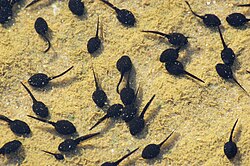| Part of a series on the |
| Wildlife of Great Britain |
|---|
 |
This is a list of amphibians of Great Britain. There are seven extant amphibian species native to Great Britain, in addition, there are a number of naturalized species and extirpated/extinct species. The extant natives comprise three newts, two toads and two frogs. Creating a complete list of native species is difficult as many subfossils have been discovered that cannot be properly identified leading to some species becoming endangered or extinct by the time they are found to be native.












